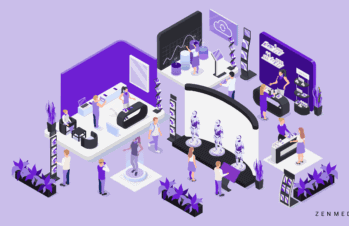Despite the fact that digital marketing is more crucial than ever for brands that want to expand, focusing all of your marketing energy – and dollars – on reaching people’s smartphones alone won’t give you a winning strategy.
Today’s consumers – connected consumers – want more than just online interaction. They want real-life engagement with the brands they follow. They want experiences. And that’s where experiential marketing comes in.
What is experiential marketing?
It’s not too difficult to figure out what experiential marketing means. The name alone gives you a good idea – it’s creating an experience for your customers.
But for a really succinct, technical definition, we like CMO magazine’s: “Experience marketing is a mutually beneficial interaction between customer and brand in an authentically branded engagement.”
In other words, an experiential marketing campaign will give your customers an opportunity to interact with your brand in a way that is unique, entertaining, informative, or (hopefully) all three. It should offer something of value to both your customer and to you, as a brand.
Now that we’ve nailed down what experiential marketing is, let’s look at why it’s so important.
Gen Z and Millennials value experiences over products
One of the most crucial things to know about marketing to Gen Z and Millennials is that their values are very different from earlier generations.
The biggest difference? They value experiences over products. According to research by Eventbrite, 78% of Millennials would rather spend money on a desirable experience than on buying a desirable object. Gen Z is continuing this trend.
What’s fueling this development? There are many factors, of course, but one is the ability we now have to share our memories and experiences with the touch of a button or tap of a screen. 60% of Millennials post, tweet, or share about their experiences – so if you’re the one providing that experience, that means they’re posting, tweeting, and sharing about your brand.
Traditional online marketing is more likely now than ever to get lost in the shuffle
The sheer volume of content that is being produced today makes it more difficult for your brand to stand out – even if your content is consistently strong.
Today’s internet users are relying more heavily on ad blockers and they’re simply tuning out marketing that feels like advertising. It’s easy to simply scroll past an Instagram video ad, or a Facebook campaign.
That’s why the most forward-thinking brands are investing heavily in experiential marketing.
By creating something exciting, unique, and most particularly, something that can be seen and experienced in the real world, these brands are making themselves stand out with their customers. They’re making themselves part of their customers’ lived experiences, and later, of their memories.
How do you create powerful experiential marketing?
Experiential marketing means giving your audience an authentic, branded experience.
So how do you do that? What do you need to know in order to create something appealing, engaging, and real?
First, and most importantly, you have to know your brand. What are your values? What does your brand stand for? What makes your brand truly unique? While the way you convey those values may change depending on the people you’re trying to reach, those basic elements of your brand should not.
Second, decide whom you’re trying to target. Demographic breakdowns are helpful, but to really hone in on your audience, try psychographic segmentation. Psychographics refers to the attitudes, beliefs, and behaviors of your audience, and this data can be especially valuable when you’re trying to develop an experiential marketing campaign.
Once you’ve got those two parts nailed down, it’s time for the hard part: What kind of experience do you want to offer?
At Zen Media, we faced this challenge recently. We’d partnered with Chase for Business for their small business conference, and our challenge was to offer participants a personalized, one-on-one experience to complement the inspiring and informative group sessions that they attended throughout the event.
We decided to create an Apple-inspired “Social Media Genius Bar” at which conference participants could take part in short, one-on-one consultations with Zen’s “Geniuses.” Participants could come with their social media and digital marketing questions, from how to drive more traffic to their website, to how to better target their social ads, and come away with actionable insight to improve their marketing.
For truly effective experiential marketing, make your experience easily shareable
Connected consumers want to share what they’re doing, seeing, and experiencing online with others – and that goes for branded experiences as much as organic ones.
Part of what makes a branded experience effective is making it easy for participants to share online. Millennials and Generation Z, especially, share what they’re doing online as a way to connect with others and build community.
When this sharing is happening around a branded experience – your branded experience – you’re giving your fans a way to further that feeling of connection with each other and your brand. This will foster greater brand loyalty, and help you develop long-term relationships with those customers.
Branded hashtags, and video and photo content are two ways you can make it easy for your audience to share online about their engagement with your brand.
Measuring the results of experiential marketing
You want your audience to have a memorable experience with your brand – but how do you measure that?
As important as it is to focus on the qualitative aspects of your engagement, you don’t want to neglect the quantitative element. You’ve got to have some way of measuring ROI so you’ll know how to improve your next experiential marketing campaign.
It doesn’t have to be terribly complicated. For some campaigns, the number of participants might be a good measure of ROI, so find a way to organically collect email addresses during your experience (include a giveaway aspect, or have participants “sign up” as part of the engagement). If that won’t work, you could station an employee with a counter where they could count the people who interact with your experience.
Another good measure of ROI is how many people take action after interacting with your brand, and what action they take.
Hashtags and content shares are just two ways to measure this. Every branded experience will be different, but here are a few common measurements you may want to use:
- How many people donated to your cause, and how much money was raised
- How many new followers you have after one day, 3 days, and/or one week
- How many new orders for your product you have
- How many unique visitors you’ve had to a landing page created specifically for your experience
It may take a little effort to find an authentic way to include a measure of ROI in your brand experience, but without it, you won’t have the data you need to discern whether the campaign actually worked.
Experiential marketing will be different for every brand, but if you start with authenticity, you’ll be on the right track.
For more, read our post “The State of Brand Storytelling in the Age of the Connected Consumer.” And if you’re ready to start your experiential marketing journey, we’d love to help. Contact us today.









